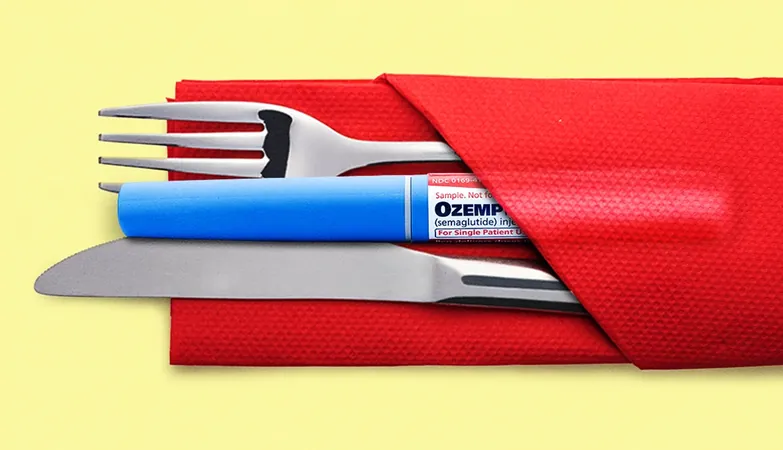
Essential Dietary Tips for Safe and Effective Weight Loss with GLP-1 Medications
2025-03-31
Author: Li
The Importance of Nutrition
Dr. Alexandra Sowa, an obesity medicine specialist and author of *The Ozempic Revolution*, emphasizes the importance of nutrition while on GLP-1 medications. With these drugs suppressing appetite and slowing gastric emptying, users often need to ensure that every meal is nutrient-dense to avoid deficiencies. In fact, 80% of GLP-1 users report side effects, particularly during the initial phases of the treatment.
Key Dietary Strategies
Here are essential dietary strategies to mitigate side effects and enhance the effectiveness of GLP-1 medications:
1. Eat High-Quality Foods
Opt for whole, minimally processed foods rich in nutrients. Focus on fruits, vegetables, lean proteins, and whole grains, as these choices support your nutritional needs and overall health. Adding supplements like Vitamin D and calcium can also be beneficial, especially for older adults who face higher risks of nutrient deficiencies.
2. Schedule Your Meals
To combat the appetite-suppressing effects of the medication, it's important to avoid skipping meals as this can lead to muscle loss and fatigue. Set regular meal times or reminders to ensure you’re taking in enough calories. Women typically require 1,600 to 2,200 calories, while men need 2,000 to 2,800—consult your healthcare provider for personalized guidance.
3. Emphasize Protein Intake
Since protein is essential for muscle maintenance and repair, aim for 20 to 40 grams of protein per meal. Sources include eggs, Greek yogurt, chicken, and legumes. Prioritizing protein can also enhance satiety, making it easier to manage food intake throughout the day.
4. Stay Hydrated
Adequate hydration is critical as GLP-1 drugs can impact thirst signals. Aim to drink at least 64 ounces of fluid daily, focusing primarily on water. If you're prone to muscle cramps, consider electrolyte supplements to help maintain balance.
5. Avoid Fats and Sugars
Users of GLP-1 medications often find high-fat and greasy foods difficult to digest, leading to discomfort. Steer clear of fried foods, fast-food meals, and sugary snacks. Instead, focus on healthier alternatives that promote stable blood sugar levels and better digestion.
6. Opt for Smaller, Frequent Meals
Instead of traditional three meals per day, consider consuming smaller, more frequent meals to help with digestion. This approach can alleviate discomfort associated with overeating and can help maintain energy levels throughout the day.
7. Add Fiber
Increasing fiber intake is crucial to combating constipation, a common side effect of GLP-1 medications. Aim for 21 to 30 grams of fiber daily by including whole grains, fruits, vegetables, and legumes in your diet.
8. Incorporate Resistance Training
To prevent muscle loss while on these medications, incorporate resistance training into your weekly routine. It is recommended to engage in this type of exercise two to three times a week, using bands, weights, or your body weight to enhance strength.
9. Monitor for Side Effects
If side effects persist or become bothersome, it’s vital to communicate openly with your healthcare provider. They can suggest appropriate management strategies, including medications for nausea or constipation.
Conclusion
Successfully navigating weight loss with GLP-1 medications can be challenging, but with the right dietary strategies and proactive health discussions, users can minimize side effects and maximize their weight loss results. Monitoring your diet, staying active, and consulting with healthcare professionals will pave the way for a healthier, more rewarding experience on your weight loss journey.





 Brasil (PT)
Brasil (PT)
 Canada (EN)
Canada (EN)
 Chile (ES)
Chile (ES)
 Česko (CS)
Česko (CS)
 대한민국 (KO)
대한민국 (KO)
 España (ES)
España (ES)
 France (FR)
France (FR)
 Hong Kong (EN)
Hong Kong (EN)
 Italia (IT)
Italia (IT)
 日本 (JA)
日本 (JA)
 Magyarország (HU)
Magyarország (HU)
 Norge (NO)
Norge (NO)
 Polska (PL)
Polska (PL)
 Schweiz (DE)
Schweiz (DE)
 Singapore (EN)
Singapore (EN)
 Sverige (SV)
Sverige (SV)
 Suomi (FI)
Suomi (FI)
 Türkiye (TR)
Türkiye (TR)
 الإمارات العربية المتحدة (AR)
الإمارات العربية المتحدة (AR)